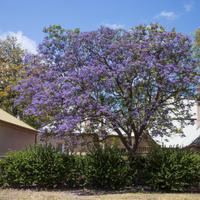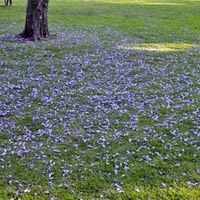Common name: Jakaranda
Other common names: Blue haze tree
Description
Jakaranda is a spectacular flowering tree originating from subtropical South America, its natural range extending across northern Argentina and southern Brazil.
It is a small tree up to 15 m (50 ft) in height, though it is typically between 5 and 10 m (16 and 33 ft) tall with a slim, straight trunk supporting a wide-branching crown. The bark is grey and fissured.
The leaves are large, up to 50 cm (20 in) long and consist of numerous tiny green leaflets in an intricate, twice-feathered arrangement. In the dry season, they fall off the tree to conserve water, leaving the branches bare until the rainy season arrives.
In spring, brilliant lavender-blue bell-shaped flowers bloom in clusters that starkly contrast with the bare branches. Less common is a white-flowering variety.
Fertilised flowers develop into small disc-shaped, woody seed capsules that become dark brown and dry. When fully mature, they split open to release their seed, which are winged, designed for wind dispersal.
.5744.jpg)
Use
Jakaranda is widely cultivated in gardens and landscapes in subtropical and tropical climates for its spectacular flowering display.
The wood is yellow-white and light- to medium-weight, ranging from 450 to 700 kgs per cubic meter (28 to 43 lbs per cubic ft). Still, low natural resistance to rot and decay makes it generally unsuitable for outdoor construction. It is, however, easy to work and fine-textured and is suitable for general carpentry or cabinetry work.
Well-formed logs from large trees are sawn into planks for making cupboards, boxes and crates or are sliced into thin sheets for decorative veneer. The branch-wood and small-diameter roundwood is pulped for plywood and particleboard or is cut into lengths and dried for firewood.
Climate
Jakaranda trees need cool, dry conditions before flowering for good flowering to occur, with the best flowering displays found in sub-humid to moderately humid subtropical and tropical climates, generally areas with annual lows of 7 to 21°C, annual highs of 18 to 35°C, annual rainfall of 500 to 1800 mm and a dry season of 7 months or less.
Although also cultivated in hot, humid climates with no dry season, flowering is usually sparse to patchy at best.
Growing
New plants usually begin from semi-hardwood cuttings or seed, which remain viable for up to twenty-four months under cold, dry, airtight storage. Trees from cuttings are preferred because they start to bloom at an earlier age.
Performs best on free-draining loam and sand soils of a moderately acid to alkaline nature, generally with a pH of 6.5 to 8.0, and on sites with full to partial sun exposure.
Problem features
Jakaranda is recorded as a serious weed in at least one reference publication. Classed as a weed of agriculture in Australia, its weediness is partly due to its ability to disperse its seed on the wind over far distances. However, it is assessed as a low weed risk species for Hawaii and Florida, respectively, by the Hawaii Pacific Weed Risk Assessment (HPWRA) project and the IFAS Assessment of Non-Native Plants in Florida's Natural Areas.
Throughout the seasons, the spent flowers, leaves and seed capsules fall to the ground creating litter.
Where it grows
References
Books
-
Adams, C. D. 1972, Flowering plants of Jamaica, University of the West Indies, Mona, Greater Kingston
-
Barwick, M., et al. 2004, Tropical & subtropical trees : a worldwide encyclopaedic guide, Thames and Hudson, London
-
Berni, C. A & Bolza, E. & Christensen, F. J. 1979, South American timbers - the characteristics, properties and uses of 190 species, Commonwealth Scientific and Industrial Research Organization (CSIRO), Division of Building Research, Highett, Victoria, Australia
-
Burke, D. 2005, The complete Burke's backyard : the ultimate book of fact sheets, Murdoch Books, New South Wales, Australia
-
Gilman, E. F. 1997, Trees for urban and suburban landscapes, Delmar Publishers, Albany, New York
-
Hall, N. 1972, The use of trees and shrubs in the dry country of Australia, Australian Government Publishing Service, Canberra, Australian Capital Territory
-
Krishen, P. 2006, Trees of Delhi : a field guide, Dorling Kindersley Publishers, Delhi
-
Little, E. L. et al. 1964 and 1974, Common trees of Puerto Rico and the Virgin Islands (2 volumes), Forest Service, U.S. Department of Agriculture (USDA), Washington D.C.
-
Luna, R. K 1996, Plantation trees, International Book Distributors, Dehradun, Uttarakhand
-
Macmillan, H. F. 1943, Tropical planting and gardening : with special reference to Ceylon, 5th ed, Macmillan Publishing, London
-
Oakman, H. 1995, Harry Oakman's what flowers when : the complete guide to flowering times in tropical and subtropical gardens, University of Queensland Press, St. Lucia, Queensland
-
Perry, B. 2010, Landscape plants for California gardens: an illustrated reference of plants for California landscapes, Land Design Publishing, Claremont, California
-
Perry, F. & Hay, R. 1982, A field guide to tropical and subtropical plants, Van Nostrand Reinhold Company, New York
-
Randall, R. P. 2002, A global compendium of weeds, R.G. and F.J. Richardson Press, Melbourne
-
Record, S. J. & Hess, R. W., 1972, Timbers of the New World, Yale University Press, New Haven, Connecticut & Arno Press, New York
-
The Garden Section of the Woman's Club of Havana 1958, Flowering plants from Cuban gardens : Plantas floridas de los jardines cubanos, Criterion Books, New York
-
Webb, D. B. 1984, A Guide to species selection for tropical and sub-tropical plantations, 2nd ed., Unit of Tropical Silviculture, Commonwealth Forestry Institute, University of Oxford, Oxfordshire
Articles, Journals, Reports and Working Papers
-
Morton, J.F. 1964, Honeybee Plants of South Florida, Proceedings of the Florida State Horticultural Society, Vol 77:415-436.
.5744.thumb.jpg)




